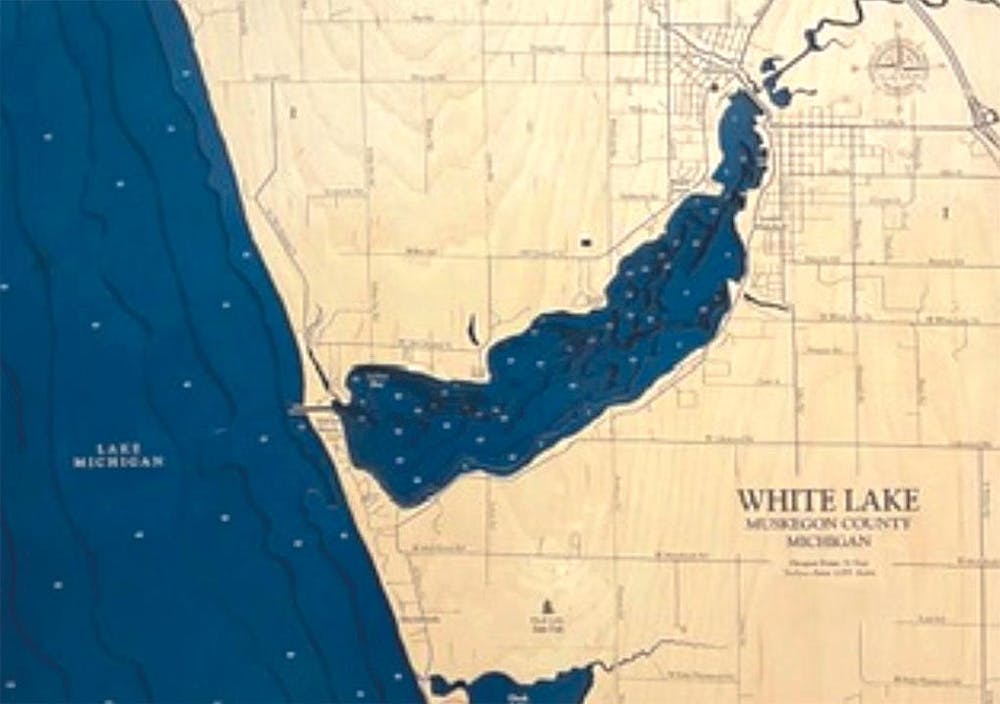In April 1837, Charles Mears and his 15-year old brother Albert, along with two men named True and Herrick, made their way from Paw Paw to White Lake. T. Stannage of Montague, John Hanson and John Barr were at White Lake in 1838. There were Native Americans at Claybanks, and Chief Wabaningo and half a dozen lodges were located on the flat near where the lighthouse now stands. In 1847 Andrew Knudsen came to White Lake. In 1850 Rev. William Montague Ferry came and built the first steam mill at the Mouth of White Lake. Scott and Stebbins ran the mill and store until 1854. Noah H. Ferry, son of Rev. W. M. Ferry, arrived in 1854 to run the mill at the Mouth.
City of Montague – The first dwelling on the site of the future village of Montague was the home and blacksmith shop and barn of Nathan Sargent, which he built in 1850. The land on which Montague now stands was first owned by Rogers and Sargent, afterwards by A. Knudson, then by G. W. Franklin and later by Ferry and Dowling.
In the fall of 1855, James Jewell and I. E. Carleton built a steam mill at Maple Grove and in 1860 it was purchased by Heald, Avery & Co.
In 1861 Noah Ferry, then managing the Ferry Steam Mill at the Mouth settlement, laid out the plans for the Village of Montague which was to be so named in Honor of his father, the Rev. William Montague Ferry.
In summer 1862, a number of local men in the White River were anxious to respond to their country’s call in the Civil War and join the Blue forces. At a meeting July 23, 1862, Noah Ferry was called to lead this group, and he said he would go and “stand by you till the last.” That evening, 82 men entered into the United States Army with Noah as Captain, H. Hefferman as 1st Lieutenant and E. C. Dicey as 2nd Lieutenant. The next day they had 102 men and became Co. F of the 5th Michigan Cavalry. They were also known as the ”White River Boys”. Noah was promoted to Major and Dicey to Captain. They led their men into many bloody battles. Noah Henry Ferry was killed at the Battle of Gettysburg July 3, 1863 at the age of 32.
Montague was platted in 1867 by Reverend William Montague Ferry, Anders Knudsen, and Even Knudsen. As part of the platting for the original village, the streets of Montague were named in honor of several Civil War heroes and in memory of Wm. Ferry’s son Noah, who was killed at the Battle of Gettysburg.
In 1865 a large iron works foundry opened in Montague, which burned three times by 1870 and was rebuilt each time. The last time it was built of bricks from Ruggles Brick Works in Whitehall, thus ending the fire problem. Over the years, it was sold several times and the name was often changed. It closed sometime after 1993 and the building was later torn down. Montague Foods was built in its place in 2001.
The post office opened in 1867 and by 1870, the village was thriving as a center for lumbering and manufacturing. Lumber cut in the mills on White Lake helped to rebuild Chicago after the great fire of 1871. Some mills cut as much as 50,000 board feet in one 12-hour day.
The Village of Montague became a city in 1935.
City of Whitehall – In 1858 Whitehall was surveyed by A. M. Hiersch, who was employed by Charles Mears and Giles B. Slocum. At the time, the area was called Mears. To make sure the members of the Slocum and Mears families and friends who helped shape the town were not forgotten, they named the streets after them.
All the streets running east and west were named by the Slocum family, and all the streets running North and South represented the Mears family.
As early as 1862 there was widespread agitation concerning the name of “Mears.” A majority of the townspeople signed a petition, which was sent to the state legislature, to have the name changed. The name of Whitehall was chosen by combining the names of Charles Whitaker and Moses Hall, mill owners who had erected an early sawmill near what is now Goodrich Park.
In 1865, Eagle Tannery Works opened in Whitehall. They closed in 2000. In August 2007 the 110-foot tower which had been used as a water tower for the tannery, was the final structure to be demolished at the 33-acre tannery property. The area is now the site of Tannery Bay, a new home construction community filled with 132 condominiums, townhomes, courtyard homes, and as well as single-family homes.
Whitehall was incorporated as a village in 1867 and became a city in 1943.
By 1873, Charles Mears and Samuel Odell had purchased land and plotted a new town of Mears in Oceana County.
In 1883, there were 13 lumber mills operating on White Lake. By the time the lumber industry peaked in the late 1880s, there were 16 sawmills that dotted the lake.
After the end of the lumbering era, many large steamships came to the area with passengers from Chicago looking to enjoy the cooling lake breezes at one of the many resorts that encircled White Lake and replaced the mills. Even after over 150 years, both towns continue to survive and thrive.
For additional information on local history, check out Remembering White Lake History on Facebook, as well as the White Lake Area Historical Society home page at www.whitelakeareahistoricalsoc...















